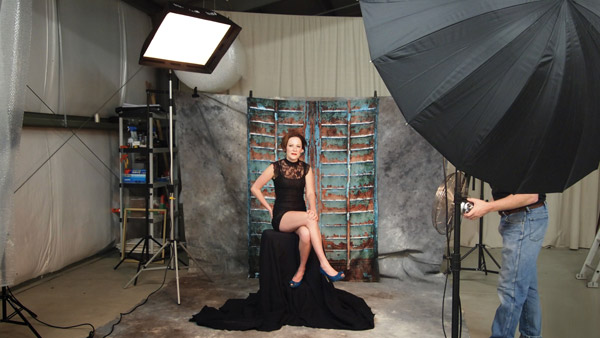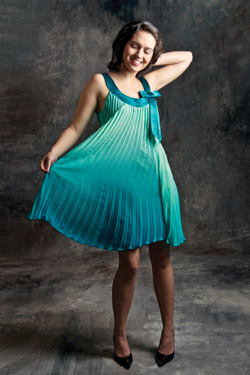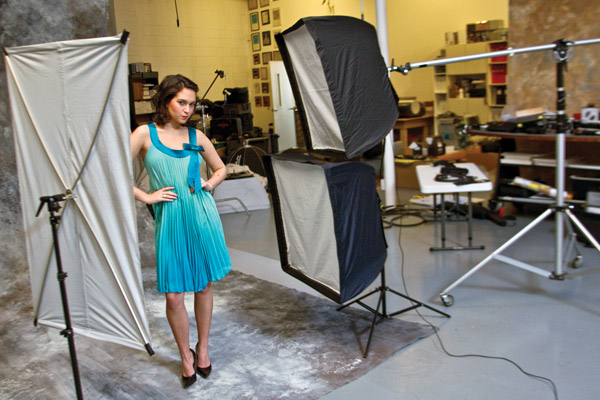Umbrellas Vs. Lightbanks: Choose The Right Lighting Tool For The Job
Let’s look at umbrellas first because of their main advantage, cost. Even big umbrellas are cheap. For example, you can buy an Adorama Camera (www.adorama.com) 40” white umbrella with a removable black cover for less than $20. Umbrellas produce a broad and soft source of lighting that could, for simplicity sake, be considered to emulate outdoor lighting. Lightbanks, on the other hand, are rectangular, octagonal or square in shape and emulate the soft, directional lighting that is produced by window light. Because umbrellas produce such broad lighting effects they are typically easier for beginners to use. You point an umbrella at a subject and bang, zoom, you’ve got soft lighting! Use 2 of them and you’ll think you’re a lighting genius.
(#1) In this behind-the-scenes shot, I was using 3 lights for photographs of Colleen in her black dress. The main light held a Dynalite (www.dynalite.com) flash head with a Booth Photographic Limited (www.boothphoto.com) 75” parabolic silver umbrella in traditional Bounce mode. An additional Dynalite head with a small lightbank mounted was used as a hair light.

© Mary Farace
(#2) Using Booth’s 75” parabolic silver umbrella Colleen was photographed with a Canon EOS 1D Mark II N and an EF 135mm f/2.8 SF lens using an exposure of 1/80 sec at f/10 and ISO 100. Because readers always ask, the backdrop is a Silverlake Photo Accessories (www.silverlakephoto.com) “Shutters” Colorsmack background.

© Joe Farace
Lightbanks are the kind of light modifiers that all the big time photographers use, so naturally that is what many beginning photographers aspire to shoot with as well. The advantage of using lightbanks is that they are controllable and available in large sizes that when placed close to a subject produce very soft, yet directional light. There are lots of accessories available, such as grids or louvers that make the lighting even across the plane of light, adding to a lightbank’s versatility. What is the downside? Even an inexpensive lightbank isn’t cheap, so all that directionality comes with a price. They are more complex to produce, so they cost more and because sizes vary from small speedlight-specific models to humongous it’s hard to find an entry-level model price tag, but you can expect to pay $100 or more. Unlike umbrellas that are forgiving, lightbanks require some basic knowledge of balancing the main versus the fill light (that fill could even be an umbrella) so it won’t produce too contrasty lighting. Unless of course that is what you really want.
(#3) For this full-length portrait, two 30” FourSquare (www.lightwaredirect.com) lightbanks, each with a single Nikon SB 800 speedlight mounted, was used. A reflector was placed at camera left. The backdrop was the “Carbonite by Joe Farace” muslin background that is available from Silverlake Photo Accessories. The camera was a Canon EOS 1D Mark IV with an EF 28-135mm f/3.5-5.6 IS lens with a final exposure of 1/100 sec at f/5.6 and ISO 200.

© Joe Farace
(#4) Here is the exact lighting set-up used to make the photograph. Two 30” lightbanks are mounted on top of one another to form a tall lightbank that lights the model from head to toe.

© Paul Peregrine
Choices are what this whole discussion of lightbanks versus umbrellas is all about. At the end of the day you should select the light modifier that matches the kind of portrait you’re trying to make. Sometimes that will require an umbrella and sometimes it will be a lightbank. There is no “one size fits all” solution to lighting and ultimately the choice is yours, based on lighting style and your budget. Just as you will select the right lens and ISO for a natural light photograph, when it comes to working with artificial light you need to select the right tool for the job.











































